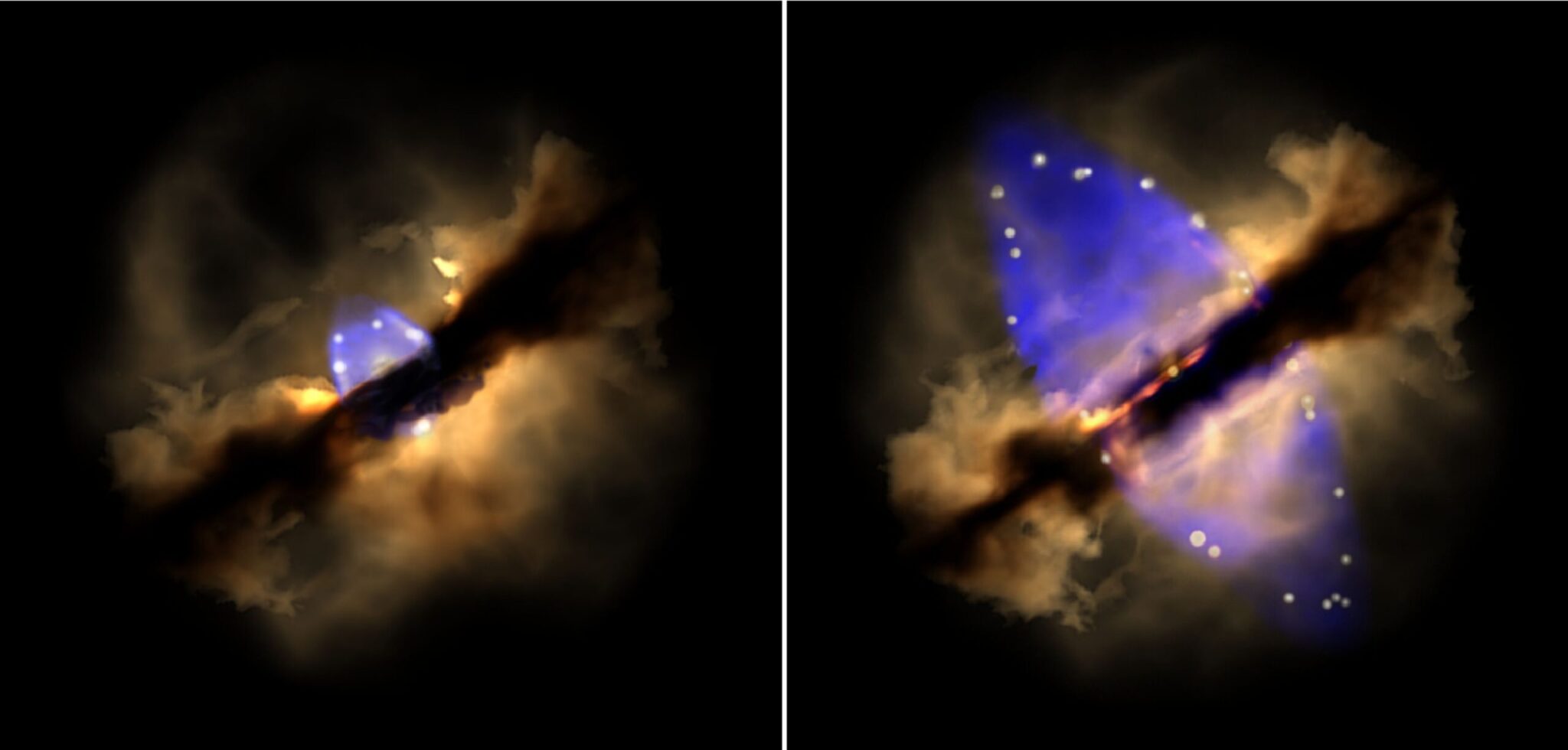Observed the formation of a stellar jet in real time [NOT TRANSLATED]

Three-dimensional hydrodynamic simulation and visualization of an episodic, short-lived, originally isotropic outflow ejection (left) from the massive protostar W75N(B)-VLA 2, whose morphology evolves into a collimated outflow (right) as it expands within a toroid of dust and gas. Credit: Wolfgang Steffen, Instituto de Astronomía, UNAM
Stars are formed inside relatively dense concentrations of interstellar gas and dust, known as molecular clouds. When denser parts of the cloud collapse under their own weight (gravity), stars are formed. Accretion of material onto the embryo star continues partially from the newly formed circumstellar disc, while developing a bipolar jet that ejects matter and energy.
The phenomenon of collimated outflows happens in diverse astronomical objects, for example, young stars, black holes in galactic nuclei, and stars at the end of their life cycles. However, how collimated outflows begin and what factors regulate their degree of collimation remain quite unknown. An international group of astronomers has observed the time when the massive protostar W75N (B) -VLA2 begins to develop a jet, which is crucial for the formation of the star itself.
The research, published in the journal Science, has the participation of researchers from the Institute of Space Sciences (IEEC-CSIC) and the Institute of Cosmos Sciences (ICCUB-IEEC) in Barcelona, from the Institute of Astrophysics of Andalusia (IAA-CSIC), and signed as first author by Carlos Carrasco-González (UNAM, Mexico).
The study shows that W75N(B)-VLA2 has dramatically changed the way in which it ejects matter. It has been observed the transition from the first regime in which the star ejects matter in all directions, and a second regime in which the ejection is along a preferred single direction, forming a jet. Although star formation processes trigger hundreds of thousands of years, researchers have been able to observe how the wind from the protostar has evolved from a compact to an elongated source in only 18 years, from 1996 to 2014.
“The current theories predict that young stars are ejecting matter in collimated outflows. However, previous studies showed that some very young massive stars go through episodic, short-lived events in which the material is ejected in all directions. We suspected that the transition from an uncollimated outflow to a collimated outflow takes place at a certain moment. This transition is exactly what we are observing in W75N(B)-VLA2,” says Guillem Anglada, a researcher from IAA-CSIC, who participates in the study.
The data are also consistent with the existence of a disk around the protostar, which completes the scenario described in models of star formation. “Our work opens a new exciting window of opportunity to study how the basic ingredients of star formation evolve over the next few years. We are lucky to be on the brink of describing and modelling in “real time” all of these rapid changes”, concludes José María Torrelles, researcher from the institutes in Barcelona
REFERENCE
C. Carrasco-González, J.M. Torrelles, J. Cantó, S. Curiel, G. Surcis, W.H.T. Vlemmings, H.J. van Langevelde, C. Goddi, G. Anglada, S.-W. Kim, J.S. Kim, J.F. Gómez. “Observing the onset of outflow collimation in a massive protostar”. Science, April 2015. DOI: 10.1126/science.aaa7216 [NOT TRANSLATED]
